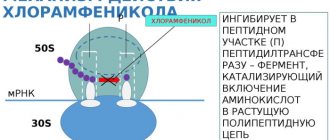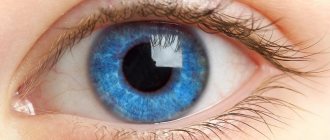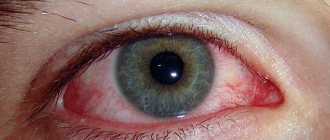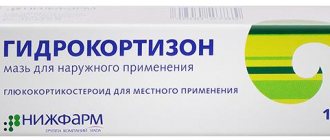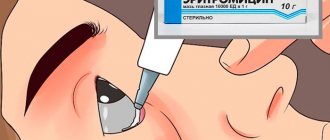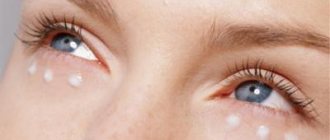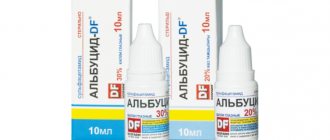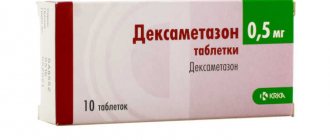Pharmacological properties of Acyclovir
A useful feature of the drug is that it does not affect healthy cells.
Acyclovir is a synthetic antiviral antiherpetic drug that is an analogue of the DNA fragment of the thymidine nucleotide. In affected cells, under the influence of viral enzymes, a structural analogue of a nucleotide is formed from it, which is inserted into the DNA molecule of the virus, blocking its copying.
In healthy, uninfected cells, where there are no viral particles, Acyclovir is not metabolized and does not have a blocking effect - human DNA is formed without defects. The drug also accumulates to a greater extent in the affected cells.
The drug reduces infection of other cells and the formation of new lesions, reducing the risk of complications, and reduces pain. Acyclovir from the drug passes well through the cornea into the intraocular fluid in an amount sufficient to suppress the virus. The drug is not detected in the blood with this method of use.
Acyclovir eye ointment is prescribed to children for the treatment of herpetic keratitis, an inflammation of the cornea caused by the simple herpes virus types 1 and 2 (Herpes simplex virus).
Acyclovir 3%-5g eye ointment
Description Antiviral (antiherpetic) drug - a synthetic analogue of thymidine nucleoside.
Indications: herpetic keratitis caused by Herpes simplex virus types 1 or 2.
Compound
1 g of eye ointment contains: active ingredient: acyclovir 30 mg; excipient: Vaseline.
Pharmacological properties
An antiviral (antiherpetic) drug is a synthetic analogue of thymidine nucleoside. In virus-infected cells containing viral thymidine kinase, phosphorylation and conversion of acyclovir to acyclovir monophosphate occurs. Under the influence of acyclovir guanylate cyclase, monophosphate is converted into diphosphate and, under the action of several cellular enzymes, into triphosphate. High selectivity of action and low toxicity to humans are due to the absence of the necessary enzyme for the formation of acyclovir triphosphate in intact cells of the macroorganism. Acyclovir triphosphate, integrating into the deoxyribonucleic acid (DNA) synthesized by the virus, blocks the reproduction of the virus. The specificity and very high selectivity of the action of acyclovir are also due to its predominant accumulation in cells affected by the herpes virus. Highly active against Herpes simplex virus types 1 and 2; the virus that causes chickenpox and herpes zoster (Varicella zoster); Epstein-Barr virus (types of viruses are listed in increasing order of the minimum inhibitory concentration (MIC) of acyclovir). Moderately active against cytomegalovirus (CMV). In case of herpes, it prevents the formation of new rash elements, reduces the likelihood of skin dissemination and visceral complications, accelerates the formation of crusts, and reduces pain in the acute phase of herpes zoster. Pharmacokinetics Acyclovir easily penetrates the corneal epithelium and creates a therapeutic concentration in the intraocular fluid. Currently, there are no methods for determining acyclovir in the blood when used as an eye ointment. When used externally, acyclovir is detected only in urine, and in small quantities. This concentration has no therapeutic value.
Indications
Herpetic keratitis caused by Herpes simplex virus types 1 or 2.
Use during pregnancy and breastfeeding
The use of the drug during pregnancy is possible only if the expected benefit to the mother outweighs the potential risk to the fetus. Acyclovir crosses the placental barrier and accumulates in breast milk. If it is necessary to take acyclovir during lactation, interruption of breastfeeding is required. For children, eye ointment in the form of a strip 1 cm long is placed in the lower conjunctival sac 5 times a day (every 4 hours) until healing. Treatment is continued for another 3 days after healing.
Contraindications
Breastfeeding period; hypersensitivity to acyclovir or valacyclovir.
Side effects
Side effects are given in accordance with the frequency of occurrence during clinical trials: very often (>10%); often (>1% and <10%); uncommon (>0.1% and <1%); rare (>0.01% and <0.1%); very rare (<0.01%). Allergic reactions: very rarely - immediate hypersensitivity reactions (including angioedema). On the part of the organ of vision: infrequently - punctate superficial keratopathy (does not require cessation of treatment and disappears without consequences); often – a slight burning sensation (passing over time); uncommon – conjunctivitis; rarely – blepharitis.
Interaction
Use together with immunostimulants enhances the effect of acyclovir.
How to take, course of administration and dosage
For adults and children, eye ointment in the form of a strip 1 cm long is placed in the lower conjunctival sac 5 times a day (every 4 hours) until healing. Treatment is continued for another 3 days after healing.
Overdose
Overdose is possible if accidentally swallowed. Symptoms: headache, neurological disorders, shortness of breath, nausea, vomiting, diarrhea, renal dysfunction, lethargy, convulsions, coma. Treatment: maintenance of vital functions, hemodialysis.
Special conditions
The earlier it is started (at the first signs of infection), the higher the effectiveness of treatment. Wearing contact lenses is not recommended during treatment with acyclovir ophthalmic ointment. To realize the therapeutic effect of acyclovir, the state of the body's immune system is important. Patients with reduced immunity against the background of topical use of acyclovir ointment should be prescribed systemic administration of the drug, as well as in the case of severe and recurrent herpetic infection. Effect on the ability to drive vehicles and operate machinery After using the drug, a temporary decrease in the clarity of visual perception is possible, and until it is restored, it is not recommended to drive a car or engage in activities that require increased attention and reaction
Release form
ointment
Storage conditions
Store in a dry place, protected from light, out of reach of children, at a temperature not exceeding 15°C.
Shelf life
3 years. After opening the tube, the eye ointment should be used within 1 month.
Conditions for dispensing from pharmacies
On prescription
Release form
ointment
Purpose
For adults as prescribed by a doctor, Pregnant women as prescribed by a doctor, Children as prescribed by a doctor
Features of use in children's practice
The use of Acyclovir eye ointment in children is permitted.
The usual daily dosage of Acyclovir in the form of an eye ointment for local use in children and adults does not differ and is about half a gram of eye ointment. A strip of ointment 1 cm long is used 5 times a day until healing and another 3 days after. Reapplication can be done after 4 hours.
The step-by-step application technique is as follows:
- Hand washing, eye rinsing if necessary, preparing gauze pads.
- Older children are seated, small children are laid down and calmed down.
- Open the tube.
- Take the tube between the index and thumb in your working hand, and a napkin in the other hand.
- Place the napkin on the bottom one and pull it down, looking up.
- Squeezing out the ointment into a 1 cm strip, place it behind the lower eyelid in the direction from the outer edge inwards.
- The eyelid is released, the eye is closed, and the tube is screwed on.
- Then you need to make circular movements with your eyes with your eyelids closed to distribute the ointment evenly, and wipe off the excess with a napkin.
When applying the ointment, do not touch the cornea and conjunctiva with the metal tip of the tube due to the high risk of injury.
If other medications are prescribed locally in the form of drops, then the ointment is applied half an hour to an hour after applying liquid forms or rinsing.
Instructions for use
It is important to consult a doctor before using an ophthalmic drug. If it is impossible to obtain prompt assistance, you should use Acyclovir eye ointment, following the instructions for use and recommendations specified in the annotation.
Instructions:
- Before the procedure, you must wash your hands thoroughly with soap.
- The installation is inserted into the lower conjunctival sac, and the dosage should be small.
- Use the fingers of one hand to gently pull back the problem area, and squeeze a strip of medication about 10 mm long into it with the other hand.
- The frequency of repetition of procedures is once every 4 hours.
Therapy is continued until the symptoms of infection are eliminated, after which for 3-4 days to consolidate the achieved results and prevent relapse.
Detailed instructions for use Acyclovir ointment
Indications and contraindications
The annotation for the medication states that the composition effectively eliminates fungal and viral infections in the mucous membrane and eliminates inflammatory processes.
Indications for use of liniment:
- acyclovir is one of the best remedies against barley;
- viral (due to the activity of herpes types 1 and 2) and adenoviral conjunctivitis;
- cytomegalovirus (with its own DNA structures);
- herpes zoster (shingles);
- Epstein-Barr virus.
The doctor individually prescribes the drug for other pathologies of a viral nature, but only after diagnosing the disease. Self-administration of the medication risks the fact that the effect of treatment will be only nominal, the symptoms of the disease will be muffled, but the problem itself will not go away.
Contraindications:
- individual intolerance to the components of the drug;
- pregnancy and breastfeeding period.
It is important to remember that after applying the medication, vision can deteriorate significantly, and therefore it is better to carry out the procedures in free and quiet time.
Directions for use and doses
The pharmaceutical product is administered into the eyes only of adults, as well as children over 4 years of age. The ointment is applied in small strips (10-12 mm) to the problem area. The average frequency of procedures is 2-3 per 24 hours. The duration of treatment is limited to 5 days.
Ophthalmologists recommend that patients not wear contact lenses during treatment.
Immediately after the administration of liniment, a burning sensation and blurred vision may be felt - these symptoms are temporary and do not require intervention from the patient. After the procedure, it is recommended to close the eyes for 5-7 minutes so that the active substance penetrates into the deep tissue structures.
Side effects
In 99.5% of cases, patients tolerate treatment with eye ointment normally. Side effects are observed in only 0.5%. The most commonly observed manifestations are:
- burning in the area of drug administration;
- conjunctivitis;
- itching, urticaria and other allergic reactions;
- superficial keratopathy;
- anaphylactic shock (as an exception).
If these symptoms occur, you should seek help from a doctor and stop using the medication.
Drug interactions
There are no officially documented and clinically verified cases of combined use of several drugs with ophthalmic ointment. It is important to understand that the parallel use of immunostimulants will enhance the effect of Acyclovir. As for the simultaneous use of ointment and nasal drops, it is better to avoid such a tandem due to the high risk of overdose.
Side effects
The drug is well tolerated in most cases. Undesirable effects are rare. Possible side effects include:
- allergic reactions - up to such manifestations of immediate hypersensitivity as Quincke's edema;
- superficial keratopathy, which then goes away without discontinuation of the drug and without the use of additional agents;
- inflammation of the eyelids;
- conjunctivitis;
- local burning sensation after applying the medicine.
If you develop the first signs of adverse reactions, or if any new complaints appear, immediately inform your doctor.
Contraindications and precautions
Often, for herpes of the eye, Acyclovir is prescribed at the same time orally, for a better antiherpetic effect.
Acyclovir ointment should not be used in patients with individual immunity to the active ingredient or derivatives of the drug (valaciclovir). It is not prescribed during breastfeeding.
The drug does not affect the reaction rate, but after its use an oily film forms on the surface of the eye, temporarily reducing the clarity of vision.
The medicine does not affect the effect of other medicines. The use of immunostimulating agents increases the effectiveness of the drug.
During treatment you should not use contact lenses.
An important feature of childhood is the development of the immune system and the imperfection of defense mechanisms. Therefore, in addition to the local use of ointment for herpes, there is often a need for systemic administration of Acyclovir to the child. It is usually taken in tablet form.
Additional systemic use of antiherpetic agents is always necessary for severe and recurrent infections.
The ointment does not contain preservatives; after opening the tube, it is best to store it in the refrigerator for no longer than a month.
